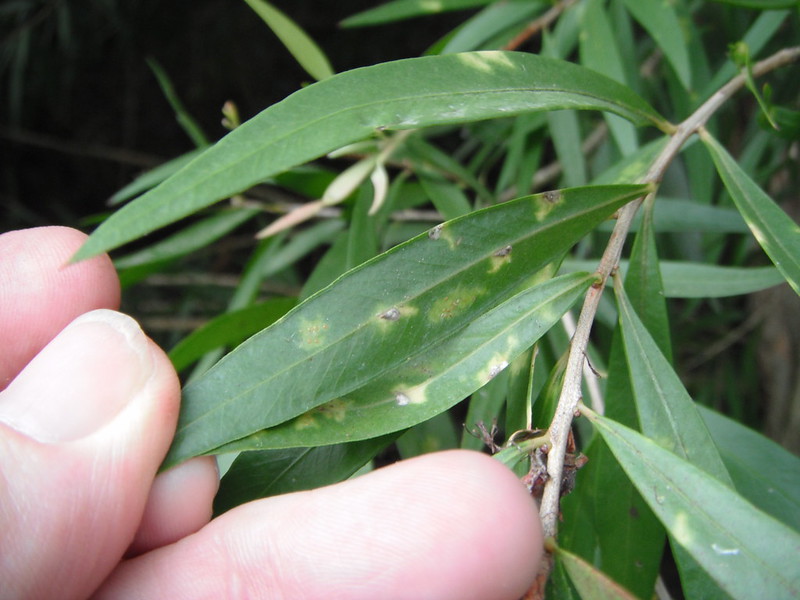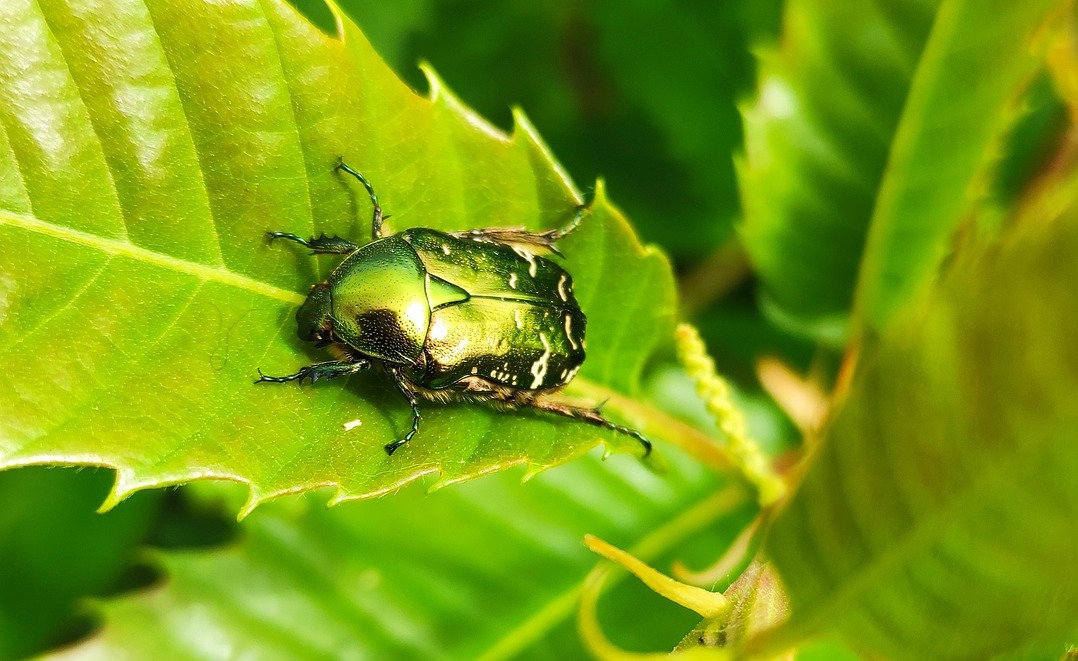The evergreen Bottlebrush, known scientifically as Callistemon spp, is a subtropical shrub native to Australia and thrives in full sun in USDA growing zones 9-11. Bottlebrush Buckeye (Aesculus parviflora) is a deciduous shrub and native to the southeastern portion of the United States. Both of these shrubs are very low maintenance and mostly trouble-free. Deer and rabbits stay away from the unpalatable leaves and may only browse on a flower here and there. There are only two main pests to be on the lookout for: Armored Scale insects (found only on the Callistemon) and Japanese Beetles.
Common Bottlebrush Pests
Armored Scale
Armored Scale, Diaspididae, sounds like it would be a difficult insect to control on woody shrubs, but it is actually the easiest of the Scale insects to get rid of. Armored Scale are sap-sucking insects that will produce many generations during the growing season. They settle on the branches and base of leaves, building a protected shell of brown ‘armor’ over themselves.

Photo by Doug Beckers, unedited, Flickr, Copyright Attribution-ShareAlike 2.0 Generic
Unlike other Scale insects, Armored Scale stays in one place on the plant, without moving during the nymph stage. This pest is generally only found on evergreen Callistemon Bottlebrush. Scale insects prefer warm temperatures year-round and are more often found in hot and sunny climates from zone 8-11 where they do not have to hibernate through the winter months.
Treating Armored Scale on Bottlebrush
Armored Scale is the easiest of the Scale insects to treat. They settle in one location on a plant, making it easy for gardeners to cut out any infected branches and dispose of them. Rarely is there a need to use insecticidal soaps or other chemical sprays on Armored Scale. Encouraging natural predators such as parasitic wasps will also help keep any infestation of the Scale insects in check. Callistemon will quickly regrow if any portion needs to be pruned away.
Preventing Armored Scale on Bottlebrush
Regular monitoring of garden plants is key to keeping any outbreak to a minimum. Do not compost infected material in the home garden. Good garden hygiene includes clearing any infected plant parts, watering plants correctly, and selecting the planting site carefully. Healthy, thriving plants are able to fend off attacks by pests and diseases.
Japanese Beetles
Japanese Beetles can be an issue for Bottlebrush Buckeye shrubs. The beetle adults emerge in late June and will feed and lay eggs nonstop for approximately the next 40 days. By the end of July, the adults will die off, having laid eggs for the next year's generation of grubs in grassy turfed areas. The grubs hatch in the late fall and proceed to feed all winter on the roots of the turf, emerging as adults to start the cycle all over again.

The adult Japanese Beetle can defoliate plants leaving skeletonized leaves behind. In the case of Bottlebrush Buckeye, the flowers can also be eaten and damaged. Younger plants may not recover as fully as more mature shrubs. Even though the plants might look alarming, they will likely recover before going dormant for winter. Continue to water and care for the shrubs as normal. Extra fertilizing will not make the plants recover quicker.
Treating Japanese Beetles on Bottlebrush
Treating Japanese Beetles is a tricky, and potentially icky thing. There are repellents and insecticides marketed to kill off or repel the beetles when they emerge. Unfortunately, many of these sprays only work temporarily and must be reapplied after any rain or overhead watering. Many of the chemicals can also harm beneficial insects such as possible beetle predators or bees.
There are also commercially available traps that attract and kill the beetles. These traps attract beetles by releasing a pheromone. If the traps are placed near plants, the beetles may get in one last meal before entering the traps. The only safe way to remove the Japanese Beetle is to pick them off the plants early or late in the day and deposit them in a bucket of soapy water. It can be time-consuming during a large outbreak but is very effective.
Preventing Japanese Beetles on Bottlebrush
The best way to treat Japanese Beetles is by preventing outbreaks from happening or at least making them smaller. Controlling populations of the grub in your turfed areas is the best way to lessen future outbreaks. Turf that is damaged by Japanese beetle grubs looks very thin and can be pulled up in large sections easily. The grubs eat the roots, causing the turf to die over time. A special bacteria called Milky Spore, Paenibacillus papillae, targets the grubs and will kill them before they have a chance to pupate. Milky Spore does not affect any other insect or animal and is extremely safe to use.
Bottlebrush Pests Chart
|
Pest |
Identifying |
Treating |
|
Armored Scale |
Shell of brown "armor" |
Cut out any infected branches and dispose |
|
Japanese Beetles |
Metallic green with coppery brown wings |
Pick pests off plants early or late in the day and drop them into soapy water |
Sources: "Bottlebrush—Callistemon spp. Family Myrtaceae (Myrtle family)." University of California Integrated Pest Management. ipm.ucanr.edu
 |
Author Robbin Small - Published 5-15-2023 |
